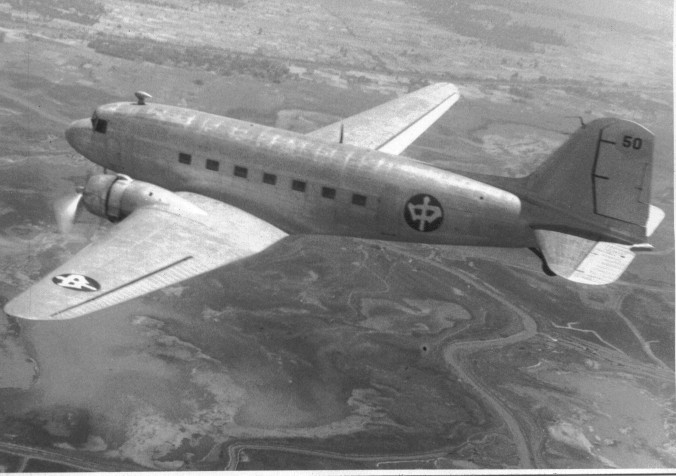Difference between revisions of "Douglas DC-53"
From CNAC
TomHutchison (talk | contribs) (Created page with "{{Aircraft |Aircraft Main Image=DC-3-CNAC-TN-50.jpg |Crew=2 |Crew Type=pilot, co-pilot }}") |
TomHutchison (talk | contribs) m |
||
| Line 3: | Line 3: | ||
|Crew=2 | |Crew=2 | ||
|Crew Type=pilot, co-pilot | |Crew Type=pilot, co-pilot | ||
| + | |Passenger Capacity=21 | ||
| + | |Passenger Capacity Max=32 | ||
| + | |Cargo Capactity=6,000 | ||
| + | |Length=64.667 | ||
| + | |Wingspan=95.167 | ||
| + | |Height=16.916 | ||
| + | |Empty Weight=16,865 | ||
| + | |Gross Weight=25,200 | ||
| + | |Powerplant=2 × Pratt & Whitney R-1830-S1C3G Twin Wasp 14-cyl. air-cooled two row radial piston engine, 1,200 hp (890 kW) each | ||
| + | |Propellers=3-bladed Hamilton Standard 23E50 series, 11 ft 6 in (3.5 m) diameter | ||
| + | |Max Speed=230 | ||
| + | |Cruise Speed=207 | ||
| + | |Range=1,500 | ||
| + | |Service Ceiling=23,200 | ||
| + | |Summary=The Douglas DC-3 is a propeller-driven airliner which had a lasting effect on the airline industry in the 1930s/1940s and World War II. It was developed as a larger, improved 14-bed sleeper version of the Douglas DC-2. It is a low-wing metal monoplane with a tailwheel landing gear, powered by two 1,200 hp (890 kW) Pratt & Whitney Twin Wasp radial piston engines. It has a cruise speed of 207 mph (333 km/h), capacity of 21 to 32 passengers or 6,000 lbs (2,700 kg) of cargo, a range of 1,500 mi (2,400 km), and could operate from short runways. | ||
| + | |||
| + | Before the war, it pioneered many air travel routes as it could cross the continental US and made worldwide flights possible, carried passengers in greater comfort, and was reliable and easy to maintain. It is considered the first airliner that could profitably carry only passengers.[4] Following the war, the airliner market was flooded with surplus military transport aircraft, and the DC-3 could not be upgraded by Douglas due to cost. | ||
}} | }} | ||
Revision as of 14:51, 16 April 2020

|
| Crew: 2 crew members2 person <br /> |
| Crew Type: pilot, co-pilot |
| Passenger Capacity: 21 to 32 passengers |
| Length: 64.667 ft19.711 m <br /> |
| Wingspan: 95.167 ft29.007 m <br /> |
| Height: 16.916 ft5.156 m <br /> |
| Cargo Capactity 6,000 lbs3 tons <br />2,721.552 kg <br /> |
| Empty Weight: 16,865 lbs8.433 tons <br />7,649.829 kg <br /> |
| Gross Weight: 25,200 lbs12.6 tons <br />11,430.518 kg <br /> |
| Powerplant: 2 × Pratt & Whitney R-1830-S1C3G Twin Wasp 14-cyl. air-cooled two row radial piston engine, 1,200 hp (890 kW) each |
| Propellers: 3-bladed Hamilton Standard 23E50 series, 11 ft 6 in (3.5 m) diameter |
| Max Speed: 230 mph199.864 kts <br />425.96 km/h <br /> |
| Cruise Speed: 207 mph179.878 kts <br />383.364 km/h <br /> |
| Range: 1,500 miles1,303.464 nm <br />2,778 km <br /> |
| Service Ceiling: 23,200 ft7,071.36 m <br /> |
Summary
The Douglas DC-3 is a propeller-driven airliner which had a lasting effect on the airline industry in the 1930s/1940s and World War II. It was developed as a larger, improved 14-bed sleeper version of the Douglas DC-2. It is a low-wing metal monoplane with a tailwheel landing gear, powered by two 1,200 hp (890 kW) Pratt & Whitney Twin Wasp radial piston engines. It has a cruise speed of 207 mph (333 km/h), capacity of 21 to 32 passengers or 6,000 lbs (2,700 kg) of cargo, a range of 1,500 mi (2,400 km), and could operate from short runways.
Before the war, it pioneered many air travel routes as it could cross the continental US and made worldwide flights possible, carried passengers in greater comfort, and was reliable and easy to maintain. It is considered the first airliner that could profitably carry only passengers.[4] Following the war, the airliner market was flooded with surplus military transport aircraft, and the DC-3 could not be upgraded by Douglas due to cost.
CNAC Aircraft Data: Douglas DC-53
Below is all the known data available for this model of this aircraft used by C.N.A.C. They are sorted by: C.N.A.C. Service Start Date, Maker Number, C.N.A.C. Tail Number.
| Tail # | Nickname | Maker # | Service Start | Service End | Crew | End Cause | Notes | Sources |
|---|---|---|---|---|---|---|---|---|
| 48 | 41-20082 | 4852 | 26 February 1942 | 11 August 1943 | Shot down by Japanese | |||
| 49 | 41-20083 | 4853 | 26 February 1942 | 13 March 1943 | Missing | |||
| 51 | 41-20109 | 4879 | 12 May 1942 | 24 March 1944 | Crash | |||
| 52 | 41-20132 | 4902 | 19 May 1942 | 10 October 1942 | Crash | |||
| 53 | 41-20134 | 4904 | 25 May 1942 | 11 March 1943 | Missing | |||
| 54 | 42-06475 | 4927 | 28 May 1942 | 1 December 1949 | To XT-45. To N8361C 12/49 | |||
| 55 | 42-06477 | 4929 | 4 June 1942 | 1 December 1949 | To XT-55. | |||
| 56 | 41-20111 | 4881 | 9 June 1942 | 12 December 1944 | Crash | |||
| 57 | 41-20113 | 4883 | 12 June 1942 | 18 February 1944 | Crash | |||
| 58 | 42-15890 | 7407 | 18 September 1942 | 7 April 1943 | Missing 7.4.43 | |||
| 59 | 42-15889 | 7406 | 7 October 1942 | 19 November 1943 | Crash | |||
| 50 | 41-20101 | 4871 | 4 December 1942 | 1 December 1949 | To XT-90. To N8367C 12/49 | Still extant! |
